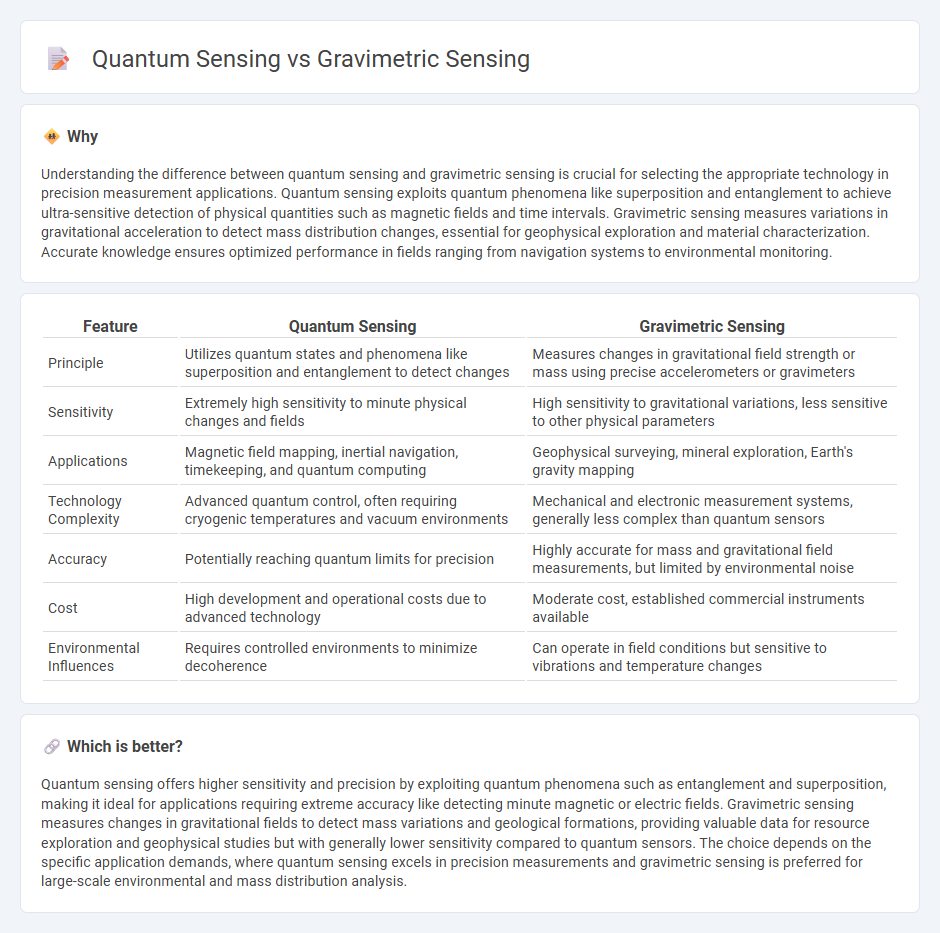
Quantum sensing leverages quantum phenomena such as superposition and entanglement to achieve unprecedented sensitivity and precision in measuring physical quantities, outperforming classical sensors in various applications. Gravimetric sensing, on the other hand, measures variations in gravitational fields to detect mass changes or subsurface structures, commonly used in geophysics and mineral exploration. Explore the emerging advantages and applications of quantum sensing compared to traditional gravimetric methods for cutting-edge technological insights.
Why it is important
Understanding the difference between quantum sensing and gravimetric sensing is crucial for selecting the appropriate technology in precision measurement applications. Quantum sensing exploits quantum phenomena like superposition and entanglement to achieve ultra-sensitive detection of physical quantities such as magnetic fields and time intervals. Gravimetric sensing measures variations in gravitational acceleration to detect mass distribution changes, essential for geophysical exploration and material characterization. Accurate knowledge ensures optimized performance in fields ranging from navigation systems to environmental monitoring.
Comparison Table
| Feature | Quantum Sensing | Gravimetric Sensing |
|---|---|---|
| Principle | Utilizes quantum states and phenomena like superposition and entanglement to detect changes | Measures changes in gravitational field strength or mass using precise accelerometers or gravimeters |
| Sensitivity | Extremely high sensitivity to minute physical changes and fields | High sensitivity to gravitational variations, less sensitive to other physical parameters |
| Applications | Magnetic field mapping, inertial navigation, timekeeping, and quantum computing | Geophysical surveying, mineral exploration, Earth's gravity mapping |
| Technology Complexity | Advanced quantum control, often requiring cryogenic temperatures and vacuum environments | Mechanical and electronic measurement systems, generally less complex than quantum sensors |
| Accuracy | Potentially reaching quantum limits for precision | Highly accurate for mass and gravitational field measurements, but limited by environmental noise |
| Cost | High development and operational costs due to advanced technology | Moderate cost, established commercial instruments available |
| Environmental Influences | Requires controlled environments to minimize decoherence | Can operate in field conditions but sensitive to vibrations and temperature changes |
Which is better?
Quantum sensing offers higher sensitivity and precision by exploiting quantum phenomena such as entanglement and superposition, making it ideal for applications requiring extreme accuracy like detecting minute magnetic or electric fields. Gravimetric sensing measures changes in gravitational fields to detect mass variations and geological formations, providing valuable data for resource exploration and geophysical studies but with generally lower sensitivity compared to quantum sensors. The choice depends on the specific application demands, where quantum sensing excels in precision measurements and gravimetric sensing is preferred for large-scale environmental and mass distribution analysis.
Connection
Quantum sensing leverages quantum phenomena such as superposition and entanglement to achieve unprecedented sensitivity in measurement, which directly enhances gravimetric sensing by improving its accuracy in detecting minute variations in gravitational fields. Gravimetric sensors utilize these quantum-based techniques to measure gravitational forces with applications in geophysics, navigation, and mineral exploration. Advances in quantum technologies enable gravimetric sensors to detect underground structures or resources with higher precision, revolutionizing fields that depend on gravitational data.
Key Terms
Mass Detection (Gravimetric Sensing)
Gravimetric sensing detects mass changes through variations in resonant frequency or oscillation of a sensor, enabling precise measurement of adsorbed or deposited materials down to picogram levels. Quantum sensing employs quantum states and entanglement to achieve exceptional sensitivity and accuracy in detecting minute mass variations, often surpassing classical limits in resolution and noise reduction. Explore detailed comparisons and applications of gravimetric and quantum sensing to understand their distinct advantages in mass detection technology.
Quantum Entanglement (Quantum Sensing)
Quantum sensing leverages quantum entanglement to achieve measurement sensitivities beyond classical limits, enhancing detection accuracy in fields like gravimetry. Gravimetric sensing relies on classical principles to measure gravitational fields, whereas quantum entanglement enables quantum sensors to detect minute changes in gravitational forces with unprecedented precision. Explore the advancements in quantum entanglement and its transformative impact on modern gravimetric sensing technologies.
Sensitivity Limits
Gravimetric sensing techniques, such as quartz crystal microbalances, typically exhibit sensitivity limits constrained by environmental noise and material properties, often detecting mass changes in the nanogram to picogram range. Quantum sensing leverages quantum states and entanglement to surpass these classical limits, achieving sensitivity at the atomic or subatomic level, down to a few atoms or even single quanta of energy. Explore the nuances of these advanced sensing technologies to understand their practical applications and future potential.
Source and External Links
Devices and methods for gravimetric sensing in liquid environments - Gravimetric sensing involves the use of piezoelectric resonators that detect changes in mass through shifts in resonant frequency, enabling detection of analytes in liquids with miniaturized devices.
Review of Gravimetric Sensing of Volatile Organic Compounds - Gravimetric sensing measures the mass of adsorbed vapors (like VOCs) directly on resonators such as quartz crystal monitors or surface acoustic wave devices, providing a sensitive method for real-time chemical detection.
Gravimetry - Wikipedia - Gravimetric sensing traditionally refers to measuring gravitational fields, but in sensing applications, it often means detecting mass changes by measuring shifts in mechanical resonator frequencies or forces.
 dowidth.com
dowidth.com